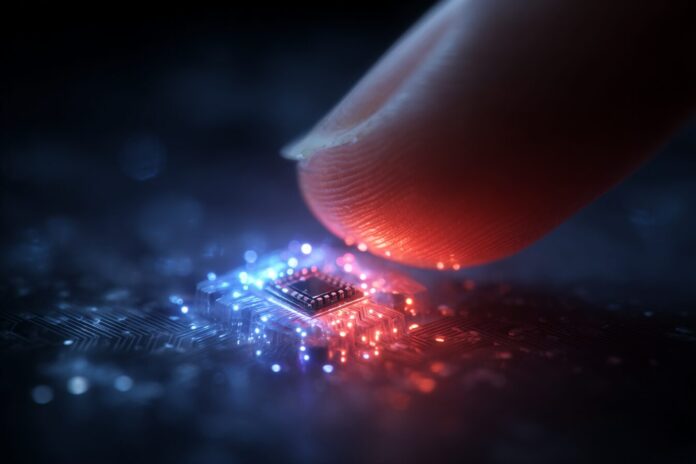Microwave Physics Powering Next-Generation AI
Artificial intelligence hardware has entered a new era. Scientists at Cornell University have unveiled a groundbreaking chip—dubbed the “microwave brain”—which processes data like a neural network while consuming less than 200 milliwatts. Most importantly, this revolutionary chip leverages the analog physics of microwaves to deliver real-time, high-speed AI capabilities in a compact, energy-efficient package. Because of its innovative design, the chip enables advanced AI computations on powerful edge devices, reducing dependency on cloud-based systems.
Furthermore, its operation is not limited to traditional computing methods. By using microwave energy, the chip performs complex tasks at a fraction of the power compared to conventional digital processors. Therefore, the potential to revolutionize edge computing and wearable technology is tremendous, as devices can operate intelligently without overtaxing their power reserves.
What Sets the “Microwave Brain” Apart?
Unlike many traditional processors that rely on binary logic and clock-driven steps, the microwave brain operates using tunable microwave waveguides. Because it employs analog computation, the chip processes information based on real-world behaviors of microwaves such as amplitude, phase, and frequency. This feature leads to faster decision-making and finer control over data processing.
In addition, the chip’s design uses physical neurons where each waveguide mimics a neuron’s behavior. As a result, it enables complex pattern recognition through natural interference and signal interactions. Besides that, the chip confidently manages data streams at tens of gigahertz, making it capable of real-time decisions with minimal latency, as highlighted in recent articles on Tom’s Hardware.
How Does It Work?
The magic of this technology lies in its unique architecture. Instead of relying on stepwise digital logic or massive memory arrays, information flows through a complex network of dynamically reconfigurable microwave pathways. Most importantly, these tunable pathways enable the chip to switch between various tasks such as data stream classification, wireless signal decoding, and radar target tracking without the need for retraining.
Because the process leverages analog physics, it bypasses many intermediate signal-processing steps found in conventional systems. Consequently, the chip achieves more functionality with less hardware and power, marking a significant leap forward in analog computing. Recent discussions on Semiconductor Digest further support its potential to transform AI-bound communication systems.
Performance and Versatility
This microwave brain chip has demonstrated 88% accuracy in wireless signal classification. In practice, its performance is comparable to that of much larger digital systems that are far more power-hungry. Therefore, it opens avenues for new breakthroughs in on-device intelligence, especially in compact and mobile technology.
Moreover, the chip’s ability to reconfigure itself dynamically to process diverse input signals allows it to handle various tasks—ranging from security anomaly detection to adaptive radio communications—with utmost efficiency. Because of these capabilities, industries such as security, telecommunications, and IoT are excited about the possibilities. The technology has already attracted attention from organizations like DARPA and the National Science Foundation, as detailed in recent coverage on Bioengineer.org.
Research Impact, Collaborations, and Future Directions
The development of the microwave brain chip represents a substantial advancement in the field of AI hardware. Researchers are collaborating across universities and industries to explore additional applications. For example, early-stage trials indicate that the chip may soon support adaptive computing environments in next-generation smartphones and wearable devices. Most importantly, these collaborations are paving the way for chips that integrate both computational and communication functionalities seamlessly.
Because this innovative approach blends physics with traditional computing, the future of edge and mobile devices is bright. With support from prominent research bodies and extensive collaborations, this technology is expected to evolve, enabling devices that can not only process high-speed data but also adapt to ever-changing environments in real time. As referenced by Mindplex Magazine, this chip could be the cornerstone of future hardware architectures.
Applications and Practical Implications
Edge AI is revolutionizing the way we think about computation outside centralized data centers. Because the microwave brain chip uses physical neurons and adaptive circuits, smart devices ranging from IoT sensors to compact robotics can perform complex tasks while maintaining low power consumption. This technological leap significantly enhances privacy, response speed, and the overall energy efficiency of AI-driven devices.
Furthermore, this innovation challenges the boundaries between communication and computation. As a heater and transmitter, the chip may eventually enable devices that function as both processors and antennas. Most importantly, such convergence could lead to the development of multifunctional systems that are both smaller and more capable than today’s technology.
Future Challenges and Opportunities
Although the microwave brain chip offers remarkable capabilities, researchers face challenges in scaling up production and integrating the chip into existing digital ecosystems. Therefore, overcoming these hurdles is essential to transition this technology from an experimental concept to mainstream applications. Because the chip uses novel microwave properties, standard manufacturing processes might require tweaking before mass adoption becomes feasible.
Besides that, ensuring the chip’s robust performance in diverse environmental conditions is another challenge. Future research will focus on enhancing the durability and adaptability of these chips, thereby widening their applications in critical domains such as medical devices, security systems, and autonomous vehicles. Emerging research shared by Hyper.AI News provides further insight into these promising future directions.
Key Takeaways
- The microwave brain chip achieves real-time, energy-efficient AI by leveraging the analog properties of microwaves rather than relying solely on silicon logic.
- Its sub-200 milliwatt power consumption redefines on-device intelligence, enhancing edge computing for wearables, IoT, and security applications.
- By combining physical neurons with adaptive microwave circuits, this technology blurs the lines between communication and computation, offering a glimpse into the future of compact AI hardware.



